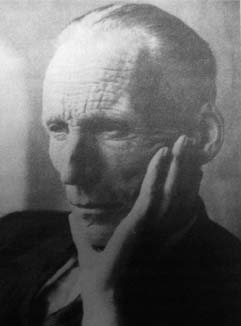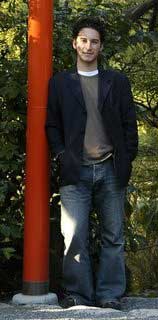
Constructive mathematics
Before the world awoke to its own finiteness and began to take the need for recycling seriously, one of the quintessential images of the working mathematician was a waste paper basket full of crumpled pieces of paper. The mathematician sits behind a large desk, furrowed brow resting on one hand, the other hand holding a stalled pencil over yet another sheet of paper soon to be crumpled and discarded.
Imagine now a curious twist on this scene, as in 1909 or thereabouts, the Dutch mathematician LEJ Brouwer sits, perhaps, amidst mounds of crumpled paper as he works on a theorem about, well, crumpled paper. We can imagine his brow to be even more furrowed than most, because while paper played on his 28-year-old mind, he had already begun to reject the type of proof he was building. Over the remaining 57 years of his life would create a revolution in our view of mathematics and logic. Brouwer can be called the father of constructivist mathematics, for while people have influenced his child, he has had the largest influence. To understand what this movement stands for, we first need to look at his crumpled paper.
A fixed point theorem

Press it flat and you'll find that one point is back in its original position.
Take first a flat sheet of paper and, imagining the most fiendishly impossible maths homework or your worst enemy (if these two are different), crumple it into a ball any way you please. Now lay this crumpled mess back on the spot where the original, uncrumpled, sheet of paper lay previously, and press it down (rather than uncrumple it) until it's absolutely flat. Unbelievable as it may seem, there is a point on the crumpled sheet of paper which is back in exactly the same spot as it was before you did the crumpling.
This result is known as a fixed point theorem, since it shows that when one thing is transformed into another — in this case, the flat sheet of paper is transformed into the crumpled one — there is a point which is "fixed under the transformation"; a point which does not change its position when the transformation is performed.
In fact Brouwer's result was not the only fixed point theorem, but was a very powerful one. It applies to any plane area which can be continuously transformed into a disc — in other words, any closed shape in the plane in a single piece and without bits missing from it. Any such shape has a fixed point when it is continuously transformed to itself. Here a continuous transformation means that some parts can be stretched or compressed, or even folded on to themselves, but no tears or holes can be made. To be transformed to itself means that the resulting shape can be made to occupy the same space (or part of it) as the untransformed shape did. Indeed, Brouwer showed that the same is true in any dimension. This means that when a sphere is transformed onto itself, it has a fixed point: when a child takes a glob of playdough and rolls it into a snake, at least one point remains fixed. And this is true of a 27-dimensional child making a 27-dimensional snake from a 27-dimensional glob of playdough.
It definitely exists...but where?
Surprising this result may be, but it seems hardly likely to start a revolution. Surprising results occur surprisingly often in mathematics — a surprising result in itself, you might say. Even Brouwer's proof used a standard and unsurprising approach not considered controversial at the time and not often considered controversial today. However, it was this type of proof, known as an existence proof, which Brouwer and his movement reject. In this type of proof, the object you are considering — in this case, a fixed point — is shown to exist with certainty. However, the proof says nothing whatsoever about where the object exists or how to find it — the treasure is certainly buried but there is no X to mark the spot. This is like saying that if a paper aeroplane hits the teacher, she is certain that someone in the class threw it, but she has no way of finding out who is the guilty culprit.

Constructive mathematics
The notion of proving only the existence of an object was soon rejected outright by Brouwer, and he started to claim that only those objects which we can actually construct should be believed. By "construct" Brouwer did not mean a model made from wire and papier-mâché, but rather a mathematical algorithm, a recipe for determining all of the features of an object. In so doing, you also get existence for free, of course, because if you construct an object then it certainly exists. A constructive proof of a fixed point theorem would tell you exactly where the fixed point is, exactly where X should mark the spot. If another theorem deals with a certain number, say the biggest element of a set of numbers, a constructivist proof would not merely say that the number exists but would rather tell you exactly what that number is, or how to calculate it.
This is usually acknowledged to be the birth of constructivism or intuitionism in mathematics — both names are used interchangeably even though neither gives the whole picture. Constructivism is a movement in the foundations of mathematics which holds that only those objects which can be constructed in the human mind from undeniably true thought processes are to be believed. In this way, it harks back to Immanuel Kant (1724-1804) and his claim that intuition alone tells us that the basics of mathematics are true. Indeed, the constructivist school has since been built on the foundation of what is known as intuitionistic logic, to distinguish it from traditional (or "classical") logic.
Did you, or didn't you?
In the real world, if a teacher confronts you and says "Did you throw this paper aeroplane or didn't you?", the correct answer is always "yes". This is because either you threw it, or you didn't throw it, so a question which asks if you did either of these things must have a positive answer. If A represents a statement such as "I threw the paper aeroplane", the only options seem to be A or "not A", the latter being the opposite of A (in our example, "not A" is "I did not throw the paper aeroplane"). If we write "not A" as ~A, then it would seem unreasonable to suppose that there is a third option beyond A and ~A. This is known in classical logic as the law of the excluded middle, or LEM for short. It says that there is no middle ground between A and ~A. What distinguishes intuitionistic logic from classical logic is the rejection of the LEM.
The truth table for the OR operator
| A | ~A | A OR ~A |
| T | F | T |
| F | T | T |
This deceptively simple distinction disguises a profound difference in viewpoint about truth and meaning. Someone who believes in classical logic is known as a Platonist or a realist. From the realist viewpoint, which is certainly the way you and I were taught mathematics and logic, the truth of a statement is determined by truth tables. If my statement reads "A or ~A", then I look at the possible values (true or false) of the bits which compose the statement, and then at how the logical operators (like OR, AND, NOT, and so on) combine those values to give the truth or falsity of the whole statement. For example, if A is true then ~A is false, and the OR operation says that "P or Q" is true when either P or Q (or both) are true. So in this case, "A or ~A" is true. The only other option is that A is false, but then ~A is true, and again "A or ~A" is true. The statement must be true because either I threw the aeroplane or I did not. But this argument rests on the idea that a statement is either true or false, which is known as bivalence. Intuitionists reject the validity of bivalence in mathematics — why?
An intuitionist believes that a mathematical statement is made true or false by the construction of a proof. In other words, a mathematical statement has no truth table value before a proof has been constructed. It is not so much that a statement exists in some weird middle ground between true and false, but rather that truth or falsity is a quality given to a statement by the construction of a proof by a human being using ideas and techniques of mathematics which are intuitively self-evident to the human mind. As such, bivalence is rejected, and therefore so is the LEM.
Pi in the sky

Luitzen Egbertus Jan Brouwer, 1881-1966, thinking hard about crumpled paper.
As an illustration, consider Brouwer's example based on the familiar number $\pi$. Brouwer used $\pi$ to provide what he claims to be a counterexample to the law of trichotomy; that law which states that every real number is either positive, negative or zero. Quite a claim, and here is how he made it. There will always be simple questions we can ask about $\pi$, the answers to which we do not yet know. Fortunately, there are well-known algorithms for generating as many digits of $\pi$ as we like, so questions like "are there ever 100 consecutive zeros in the decimal expansion of $\pi$" may be answered in the affirmative one day, when we have sufficient computing power to follow the algorithms through to a large number of digits. But if we have never yet found 100 consecutive zeros, then we can't say that there is no such run of zeros. In this way we can always formulate a question such as this, be it 100 zeros or 457 sixes, or what have you. Let S be one of those statements, maybe "there are 100 consecutive zeros in the decimal expansion of $\pi$". To most mathematicians and I suspect most of you, the statement "S or not S" is true. That is, even if we haven't yet found the place in the decimal expansion of $\pi$ where the 100 zeros occur, either it is lurking there waiting for our chugging computers to get to it, or it does not exist at all. But the constructivist disagrees because of her rejection of the law of the excluded middle. The constructivist argues that it is a mistake to think of the decimal expansion of $\pi$ existing "out there" somewhere as an object independent of the human mind. To the constructivist, the decimal expansion of $\pi$ only exists up to the truncated point to which it has been calculated by humans (or our proxies, the computers). Things get even worse for the realist, better for the constructivist, when we bring in Brouwer's number $\hat{\pi}$ (called "pi hat"). Suppose, he said, that we go on calculating $\pi$ until we find the first run of 100 consecutive zeros. If it starts at the nth decimal place and n is odd, then let $\hat{\pi}$ terminate at its nth digit. If n is even, let the (n+1)th digit of $\hat{\pi}$ be 1 and then terminate its decimal expansion. The key points to bear in mind are the following. We have a perfectly decent construction for $\hat{\pi}$: just calculate $\pi$ and let the two numbers be equal until we hit a run of 100 zeros in $\pi$, at which point follow the rules above. We do not know at present, and probably never will, whether such an n even exists. No matter, we can still discuss the quantity $Q=\hat{\pi}-\pi$. If no run of 100 consecutive zeros ever appears then $\hat{\pi}=\pi$ and $Q=0$. If such a run appears and begins at an even place in the expansion, then $\hat{\pi}>\pi$ and $Q>0$; if at an odd place then $Q<0$.

To constructivists, pi only exists up to the truncated point to which it has been calculated.
The problem is that if after a billion years of calculating squadribblioblions of digits of $\pi$ we still have not found a run of 100 consecutive zeros (or whatever our simple statement says), then we still do not know whether $Q$ is positive, negative, or zero, and are no closer whatsoever to an answer. But the law of trichotomy, from a classical standpoint, asserts that $Q$ is either positive, negative, or zero, regardless of the fact that we will never know which. In other words, there are situations in which we can never determine, even in principle, whether a number is positive, negative, or zero, and yet the law of trichotomy would insist that one must be true. What meaning can we give to this law, when such a simple construction reveals it to be effectively meaningless? A constructivist says that $Q$ will be one of the three when (if) we ever get to a run of 100 zeros, but is none of them beforehand. The disturbing fact for realists is that this implies that mathematics is subjective and time-dependent, indeed that it is also dependent on such messy things as history and culture. \\ Most mathematicians quickly reject this argument and say instead that $Q$ is either positive, negative, or zero, we simply don't know which. This illustrates how firmly entrenched is the realist view that mathematical objects exist independently of the human mind, "out there" somewhere just waiting to be discovered, even in our every day conception of objects as fundamental as the real numbers. Intuitionism is radically antirealist: antirealist in that it claims mathematical objects only come into existence once they are constructed by a human mind (a sad quirk of language that this is called "anti"realist), and radical since it seeks to recast all of mathematics in this light.
We have looked here at a couple of telling examples of the problems constructivists see in the realist view of mathematics, and much more on this fascinating topic and its history can be found in the suggested reading below. But what has been the effect on modern mathematics of this revelatory and revolutionary viewpoint? Surprisingly little, which is surprising in itself (see above). Mathematics is still taught with an underpinning, explicitly acknowledged or not, of a realist, classical logic. Proof by contradiction, existence proofs, and other methods and types of proof shown to rest on shaky foundations by the constructivists are still taught as standard to undergraduates around the world. At even the earliest stages in our schools, children are taught implicitly of numbers as existing independently of human minds and awaiting discovery. Professional mathematicians tend largely to ignore the issue; the only emotion constructivist arguments elicit tending to be annoyance. The jury is still out on whether mathematics exists independently of us, or is purely a product of the human mind, or some combination of the two. But to assume knowledge of the verdict before it has been delivered is to resort to a reliance on faith which even the realists would usually reject.
Suggested reading
- The Mathematical Experience by PJ Davis & R Hersh;
- Philosophy of Mathematics edited by P Benacerraf & H Putnam;
- The Wikipedia page on constructive mathematics.
About the author

Phil Wilson is a lecturer in mathematics at the University of Canterbury, New Zealand. He applies mathematics to the biological, medical, industrial, and natural worlds.